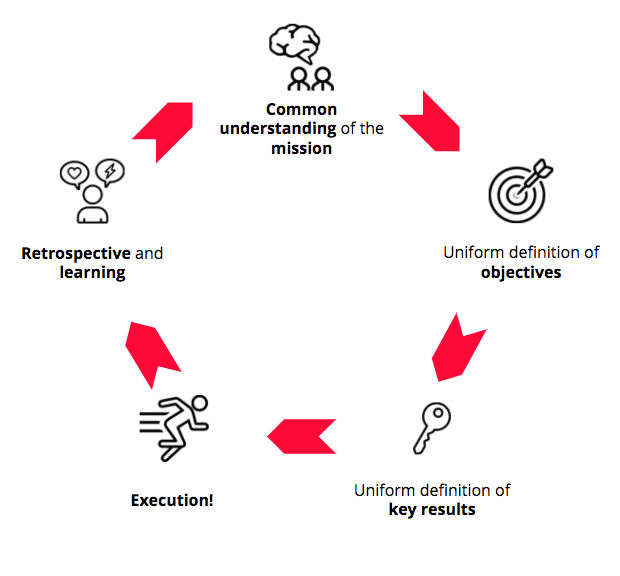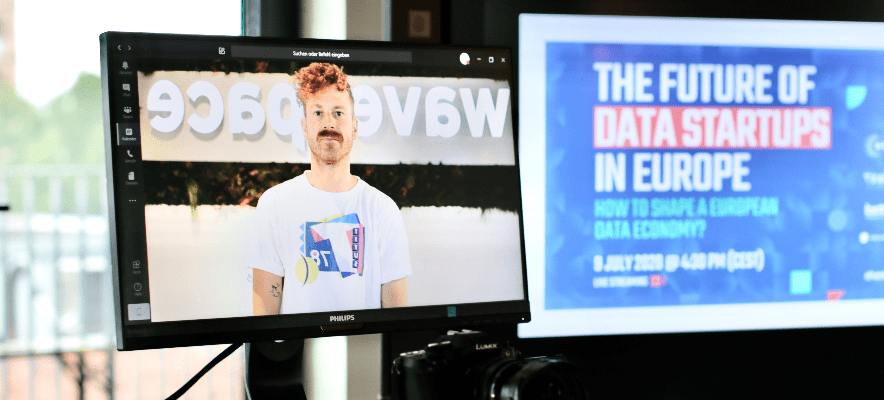#DIGITALLEARNING 3 – Objectives & Key Results (OKRs)
27. February 2018
Knowledge is power – especially when it comes to digitization. That’s why we regularly present our readers with the #DIGITALLEARNING blog series, providing them with methods, tools and know-how about digitization and innovation. Today’s article deals with OKRs – the leadership method using Objectives and Key Results.
What are OKRs?
Objectives and Key Results – in short: OKRs – have been used for years by many companies such as Google, Oracle or LinkedIn to define goals at corporate, team or employee level and to make progress measurable. Measurable key results are assigned to each goal and their achievement is evaluated at regular intervals. OKRs are first defined at the company level, from which team OKRs and personal OKRs for individual employees can be derived and measured.
An OKR always consists of a qualitative, meaningful goal (objective) and one or more quantitative results (key results). This ensures that the agreed OKRs are inspiring, ambitious, measurable and observable. For example, this may be a possible definition: I/we achieve __, and measure this with __.
With OKRs, too, less is more. They should serve to set clear priorities within the organization. Therefore, each team and each individual should have a maximum of five objectives and five key results per objective.
How do OKRs work?
The following figure shows an OKR process – from the definition of a mission to the retrospective.

First of all, the team agrees on a joint mission. This could be for example:
Mission: We only want to develop products that our customers really need.
Then, based on the mission, the team determines the objectives which are both meaningful and ambitious.
Objective 1: We understand what our users and non-users really think.
Objective 2: We test our products on real users.
Next, the team formulates key results for each objective. The defined key results are simply formulated and quantitatively measurable – both their 100 percent achievement and progress on the way there. These could be as follows:
Objective 1:
KR1: The sales team conducts 50 telephone interviews with our key accounts.
KR2: The support team conducts 50 telephone interviews with lost customers.
KR3: The product management interviews 25 non-users.
Objective 2:
KR1: We conduct at least 21 face-to-face user tests and interview sessions.
KR2: We receive at least 15 video interviews from usertesting.com.
After the OKRs have been defined, the iteration begins, in which the team works autonomously and without changing the OKRs to fulfill them (comparable to the Scrum Sprints). After the iteration, there is always a retrospective in which the team discusses how the OKRs were fulfilled, if there were problems, what worked out well and what should be done better in the next iteration. OKRs that have not been reached or have only been reached partially are transferred to the next round.
What makes OKRs special?
Dynamism: OKRs are not defined annually within a static planning process, but rather in shorter target cycles of usually three months to enable dynamic planning and rapid adaptation to changes. However, OKRs must not be changed within an iteration.
Motivation: OKRs are often so-called “stretch goals”, i. e. targets whose 100 percent achievement is unlikely. In this way, the teams leave their comfort zone and can achieve more than they would have thought was possible. At the same time, performance assessment and remuneration are treated independently of each other. This motivates them to set themselves more difficult, higher-quality targets because they are not in danger of being negatively impacted by non-achievement.
Transparency: Since goals are defined first for teams and then for individuals, team members are dependent on internal communication to ensure transparency about their progress. This results in a regular exchange of ideas, which has a positive effect not only on the achievement of goals but also on team dynamics. Usually, OKRs are visible to the entire organization at all hierarchy levels, for example, via the intranet. This transparency ensures that everyone works towards the same results.
Self-responsibility: OKRs provide a common understanding of why certain objectives are defined and make it possible to measure the achievement of objectives by means of clearly defined results. At the same time, however, they allow the teams a maximum of freedom with regard to the “how” – who takes on which responsibilities and when which interim results should be available. In other words, they work largely independently within an iteration.





* Required field